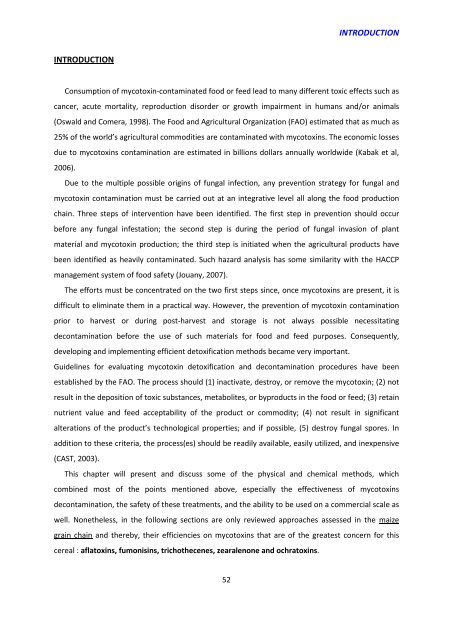Effet chez le porcelet d'une exposition à un régime co-contaminé en ...
Effet chez le porcelet d'une exposition à un régime co-contaminé en ...
Effet chez le porcelet d'une exposition à un régime co-contaminé en ...
Create successful ePaper yourself
Turn your PDF publications into a flip-book with our unique Google optimized e-Paper software.
INTRODUCTIONINTRODUCTIONConsumption of my<strong>co</strong>toxin-<strong>co</strong>ntaminated food or feed <strong>le</strong>ad to many differ<strong>en</strong>t toxic effects such ascancer, acute mortality, reproduction disorder or growth impairm<strong>en</strong>t in humans and/or animals(Oswald and Comera, 1998). The Food and Agricultural Organization (FAO) estimated that as much as25% of the world’s agricultural <strong>co</strong>mmodities are <strong>co</strong>ntaminated with my<strong>co</strong>toxins. The e<strong>co</strong>nomic lossesdue to my<strong>co</strong>toxins <strong>co</strong>ntamination are estimated in billions dollars annually worldwide (Kabak et al,2006).Due to the multip<strong>le</strong> possib<strong>le</strong> origins of f<strong>un</strong>gal infection, any prev<strong>en</strong>tion strategy for f<strong>un</strong>gal andmy<strong>co</strong>toxin <strong>co</strong>ntamination must be carried out at an integrative <strong>le</strong>vel all along the food productionchain. Three steps of interv<strong>en</strong>tion have be<strong>en</strong> id<strong>en</strong>tified. The first step in prev<strong>en</strong>tion should occurbefore any f<strong>un</strong>gal infestation; the se<strong>co</strong>nd step is during the period of f<strong>un</strong>gal invasion of plantmaterial and my<strong>co</strong>toxin production; the third step is initiated wh<strong>en</strong> the agricultural products havebe<strong>en</strong> id<strong>en</strong>tified as heavily <strong>co</strong>ntaminated. Such hazard analysis has some similarity with the HACCPmanagem<strong>en</strong>t system of food safety (Jouany, 2007).The efforts must be <strong>co</strong>nc<strong>en</strong>trated on the two first steps since, once my<strong>co</strong>toxins are pres<strong>en</strong>t, it isdifficult to eliminate them in a practical way. However, the prev<strong>en</strong>tion of my<strong>co</strong>toxin <strong>co</strong>ntaminationprior to harvest or during post-harvest and storage is not always possib<strong>le</strong> necessitatingde<strong>co</strong>ntamination before the use of such materials for food and feed purposes. Consequ<strong>en</strong>tly,developing and imp<strong>le</strong>m<strong>en</strong>ting effici<strong>en</strong>t detoxification methods became very important.Guidelines for evaluating my<strong>co</strong>toxin detoxification and de<strong>co</strong>ntamination procedures have be<strong>en</strong>established by the FAO. The process should (1) inactivate, destroy, or remove the my<strong>co</strong>toxin; (2) notresult in the deposition of toxic substances, metabolites, or byproducts in the food or feed; (3) retainnutri<strong>en</strong>t value and feed acceptability of the product or <strong>co</strong>mmodity; (4) not result in significantalterations of the product’s technological properties; and if possib<strong>le</strong>, (5) destroy f<strong>un</strong>gal spores. Inaddition to these criteria, the process(es) should be readily availab<strong>le</strong>, easily utilized, and inexp<strong>en</strong>sive(CAST, 2003).This chapter will pres<strong>en</strong>t and discuss some of the physical and chemical methods, which<strong>co</strong>mbined most of the points m<strong>en</strong>tioned above, especially the effectiv<strong>en</strong>ess of my<strong>co</strong>toxinsde<strong>co</strong>ntamination, the safety of these treatm<strong>en</strong>ts, and the ability to be used on a <strong>co</strong>mmercial sca<strong>le</strong> aswell. Nonethe<strong>le</strong>ss, in the following sections are only reviewed approaches assessed in the maizegrain chain and thereby, their effici<strong>en</strong>cies on my<strong>co</strong>toxins that are of the greatest <strong>co</strong>ncern for thiscereal : aflatoxins, fumonisins, trichothec<strong>en</strong>es, zeara<strong>le</strong>none and ochratoxins.52

















